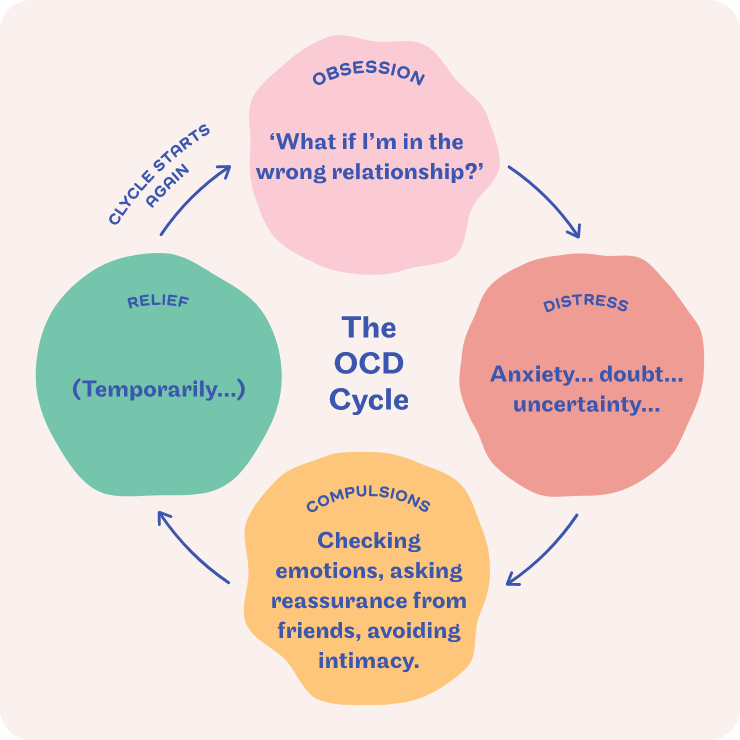What Is OCD (Really) And How to Manage It
Not an immaculate room. Not a color-coded filing cabinet. Rather: a slew of slippery thoughts that cause suffering and require expert treatment.
I recently wrote and submitted a detailed story of my OCD journey that I hope will be picked up for publication. Additionally, I just upped my meds (having a baby will do that to you), so I figured that it would be a good time to share some background info.

I battled anxiety and depression for 8 years before I was diagnosed with OCD.
Typically when people hear that term, a specific image enters their mind: a spotless desk where everything has its place. Someone scrubbing their tile floors with a toothbrush. A person repeating odd phrases or rituals multiple times (cough cough, Sheldon from Big Bang Theory).
I’ve never had the cleanest room or the strictest grooming habits. My OCD is more devious – torturing me from the inside.
As anyone who has struggled with their mental health knows: the mind can be a dangerous place.
Before diving into the various subtypes, it’s important to understand that OCD has two components (as stated in its name): obsessions and compulsions. The obsessions, which come in the form of thoughts or ideas, trigger the compulsions. The compulsions are the actions that a person takes to combat the obsessive thoughts. Sometimes, compulsions are purely mental and entail thinking habitual thoughts, engaging in repetitive self-talk or and/or conjuring up specific memories (this type of OCD has also been called “Pure-O”).
Some of the more well-known subtypes include:
Contamination obsessions with cleaning compulsions
Symmetry obsessions with ordering compulsions
Obsessions and compulsions around rituals and repetition
Hoarding OCD
Other lesser-known and more taboo categories of Obsessive-Compulsive Disorder include:
Harm/Violent OCD (thoughts of harming themselves or others)
Sexual Orientation OCD (doubts about one’s sexual identity/orientation)
Pedophile OCD (worries about being attracted to kids)
Relationship OCD (ruminating about whether you are with the “right” person)
And more
In truth, there are endless themes of OCD, because it can occur whenever a distressing thought becomes “stuck” in a person’s mind. The sticky thought causes a stress response in the body and a continuous cycle of anxiety.
For example, someone with Harm OCD may have this thought while cooking dinner:
I could stab my husband with this kitchen knife.
Since the thought causes anxiety, they might respond to it with a mental compulsion that involves convincing themselves that they are a good person:
No, I would never do that, I’m a good person. Right? That’s a crazy thought, I’m not a crazy person! I would never do that … would I? Why am I thinking about this?
By engaging with the thought rather than just letting it go, a person with OCD incorrectly signals to their brain that the thought is important and meaningful. This starts a chain reaction. Since the thought is upsetting to them, they begin to feel anxious – elevated heart rate, sweaty palms, short-of-breath. These bodily reactions make the thought seem even more scary and threatening, causing them fight it with more compulsions. Thus continuing the cycle of OCD:
Image source: https://soocd.com.au/all-about-ocd/what-is-ocd/
Now, let me be clear: everyone has scary thoughts. Everyone. Most people are able to brush them off without much strife, but for a person with OCD, they cause extreme stress and disrupt daily living.
When my OCD reached its peak, I could barely get out of bed in the morning. I spent hours performing compulsions (researching, reassurance-seeking, mental compulsions) which left time for little else in my day. My relationships suffered. I had difficulty focusing on anything else but my intrusive thoughts. They were controlling my life, and I hated myself for it.
Each case of OCD manifests differently. Symptoms vary in type and severity. But ultimately it all boils down to this:
The root cause of OCD is the intolerance of uncertainty.
In the psych community, OCD is known as the “disease of doubt” and it actually falls on the spectrum of anxiety and panic disorders.
Therefore, treatment of OCD involves accepting that one can never actually be 100% certain of anything.
Back to our example of the person with harm OCD: we can reasonably conclude that she most likely will not stab her husband. We can be 99.9% sure, but there is no guarantee. Life is unpredictable, and anything could happen:
What if the knife accidentally slips out of her hands?
What if she has a manic episode?
What if her husband suddenly attacks her?
What if .. what if?
In order to manage the obsessive thoughts, this OCD sufferer must learn to accept the small degree of uncertainty that she could possibly stab her husband. If not, she’ll continue to ask herself: Could I really do that? Am I truly a monster? Am I the type of person who could stab someone?
In other words, healing from OCD requires sitting with the “what-ifs” without letting them drive you insane.
Absolute certainty doesn’t exist. So, the only way to handle these intrusive thoughts is to acknowledge them by saying “Eh, maybe so, but probably not. I’ll never know for sure, and that’s ok.”
A nonchalant approach to the thoughts makes them less scary and thus less sticky, allowing a person with OCD to move on with their life.
This is an oversimplified example, and I am not a professional. All I can do is speak from my own experience with OCD, which has fundamentally changed my outlook on life. Befriending uncertainty has given me a freedom and peace that I wouldn’t have known otherwise. I think that everyone, regardless of their mental health status, could benefit by learning how to tolerate life’s inevitable doubts.
I’ll share more about this soon – my book on this theme is still in the works – so stay tuned!
Sources & Resources:
https://iocdf.org/expert-opinions/subtypes-of-ocd/
https://www.verywellmind.com/what-are-the-different-types-of-ocd-2510663
https://www.treatmyocd.com/blog/a-quick-guide-to-some-common-ocd-subtypes
https://time.com/6286178/intrusive-thoughts-meaning-treatment/
https://www.medicalnewstoday.com/articles/intrusive-thoughts#myths


